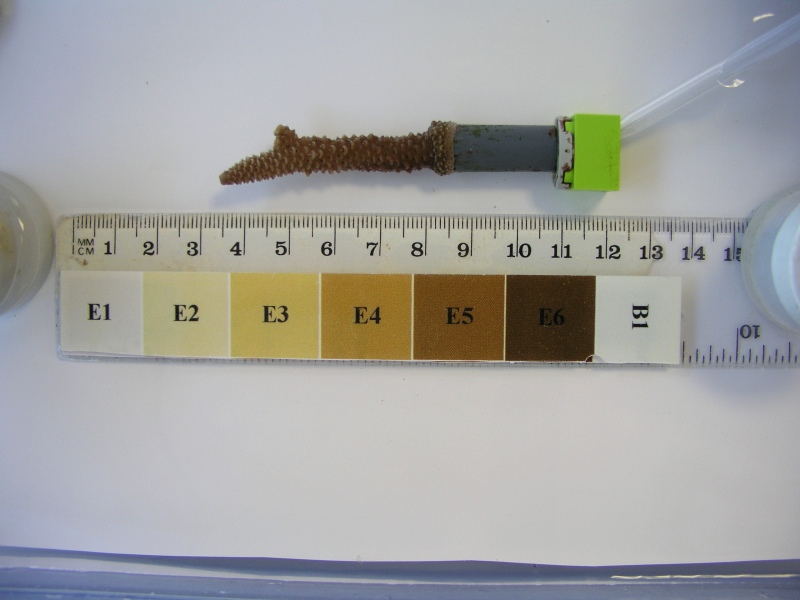Acropora millepora
Type of resources
Topics
Keywords
Contact for the resource
Provided by
Representation types
status
-

This dataset consists of one data file from a 16 day aquarium experiment manipulating pH and light level and measuring growth, photosynthesis, calcification and pigment content of Acropora millepora. The aim of this study was to test the hypothesis that a combined effect of decreased pH and decreased light on physiological responses of the coral is larger than that of each stressor individually. Method: Colonies of the coral Acropora millepora were collected from an inshore fringing reef next to Pelorus Island (central section of the Great Barrier Reef (GBR); 18° 33.001’ S, 146° 29.304’ E) between 2 and 4 m below lowest astronomical tide (LAT). After colonies were fragmented, individual coral nubbins were glued onto stubs and kept at the Australian Institute of Marine Science (AIMS, Townsville) in flow-through (recirculating flow ~1200 l h-1) aquaria facilities under plasma light (150 µmol photons m-2 s-1) for >3 mo. Nubbins were transferred into experimental tanks 2 weeks prior to the start of experiment to acclimate to experimental control conditions. Light levels chosen as the control and low light conditions were well within average ranges found between 3 and 6 m below LAT at midshelf and inshore reefs on the GBR, respectively. The manipulative aquaria experiment was carried out in flow-through conditions over a period of 16 days between July and August 2012 at AIMS. After two weeks acclimation, four nubbins of A. millepora were allocated to each of the twelve experimental aquaria. Four treatments with three replicate tanks (working volume 17.5 L) were placed in alternating order. Treatments consisted of combinations of ambient pCO2 (427 µatm), high pCO2 (1073 µatm), low light (35 µmol photons m-2 s-1) and control light (150 µmol photons m-2 s-1). Light intensities were chosen from average PAR readings from an inshore and mid-shelf reef at ~ 5 m below LAT, present during the summer months. Water flow was provided with fresh filtered (0.5 µm) seawater at 25 °C, with a salinity of 34.5, at a flow-rate of 150 mL min-1. Irradiance was delivered by white light LED (6000 K, Aqua Illumination), covering the full color spectrum. Light levels were set to 12 h/ 12 h light-dark cycle. Additional aquaria pumps (AquarWorld, Australia, 250 L h-1) were fitted into each tank to assure water movement. Target pH levels were achieved by an automatic CO2 injection system (Aqua Medic, Germany) controlled by potentiometric pH sensors. Growth of organisms was determined by the buoyant weight technique. Individual specimens were single-weighted (accuracy: 0.1 mg, Mettler Toledo, USA) in a custom build buoyant weight set-up with water jacket and seawater of constant temperature (25 °C) and salinity (34.5 ppt) at the start and at the end of the experiment. Growth of organisms was expressed as daily percentage of change. After 16 days in experimental conditions, two individuals of each replicate tank were incubated for 1 h in the light and thereafter 1 h in the dark to determine calcification and photosynthesis. Light intensity and seawater pH of incubations corresponded to treatment condition of each organism. One experimental run consisted of 12 parallel incubations in 200 mL incubation chambers, including two blanks per treatment. To assure constant water temperature during incubation, chambers were placed into a flow-through water bath at 25 °C. Additionally, magnetic stirrer bars ensured water movement within the incubation chambers. Calcification rates in light and dark were determined by the alkalinity anomaly technique (Chisholm & Gattuso 1991). A subsample of 50 mL was pipetted from the incubation seawater and directly titrated for total alkalinity (AT) on a Metrohm 855. A change in one mole of AT corresponds to a change of half a mole of calcium carbonate (Gao and Zheng 2010). Thus, calcification can be expressed by determining the change of carbon in calcium carbonate. Calcium carbonate precipitation or dissolution in µM C h-1 was calculated following Gao and Zheng (2010) and standardized to organisms’ surface area. Net photosynthesis in the light or dark respiration were monitored consecutively during the incubations by three Firesting 4-channel oxygen meters (Pyroscience, Germany), which were connected to each chamber with fibre optic cables. Gross photosynthesis, net photosynthesis and respiration rates were expressed as µM O2 h-1 and standardized to organism surface area. Chlorophyll a content of coral A. millepora was determined after coral tissue was stripped from the skeleton with an air gun utilizing fresh, ultra-filtered (0.2 µm) seawater. Zooxanthellae were isolated from the host tissue and re-suspended in 2 mL of ethanol (EtOH 95%), heat shocked and extracted for 24h in the cold. Absorbencies were read on 750 and 664 nm and Chl a content was calculated standardized to nubbin surface area. References: Gao K, Zheng Y (2010) Combined effects of ocean acidification and solar UV radiation on photosynthesis, growth, pigmentation and calcification of the coralline alga Corallina sessilis (Rhodophyta). Global Change Biol 16:2388-2398 Chisholm JRM, Gattuso JP (1991) Validation of the alkalinity anomaly technique for investigating calcification and photosynthesis in coral-reef communities. Limnol Oceanogr 36:1232-1239 Format: A single csv text file, Acid_Light_Millepora_Growth.csv Data Dictionary: - Tank: running number of tanks in experiment - pH: single factor pH - Light: single factor light - Treatment: combined factor of pH and light - Growth: increase in buoyant weight of coral after 16 days of experimental treatment given in % change d-1 - Light calcification: calcification in light, given in µM C h-1 cm-2 - Dark calcification: calcification in darkness, given in µM C h-1 cm-2 - Net calcification: light calcification + dark calcification - Net photosynthesis: oxygen production during light, given in µM O2 h-1 cm-2 - Respiration: oxygen consumption during darkness, given in µM O2 h-1 cm-2 - Gross photosynthesis: net photosynthesis – respiration - Chlorophyll: Chlorophyll a content after 16 days in experimental conditions, given in µg cm-2
 eAtlas Data Catalogue
eAtlas Data Catalogue